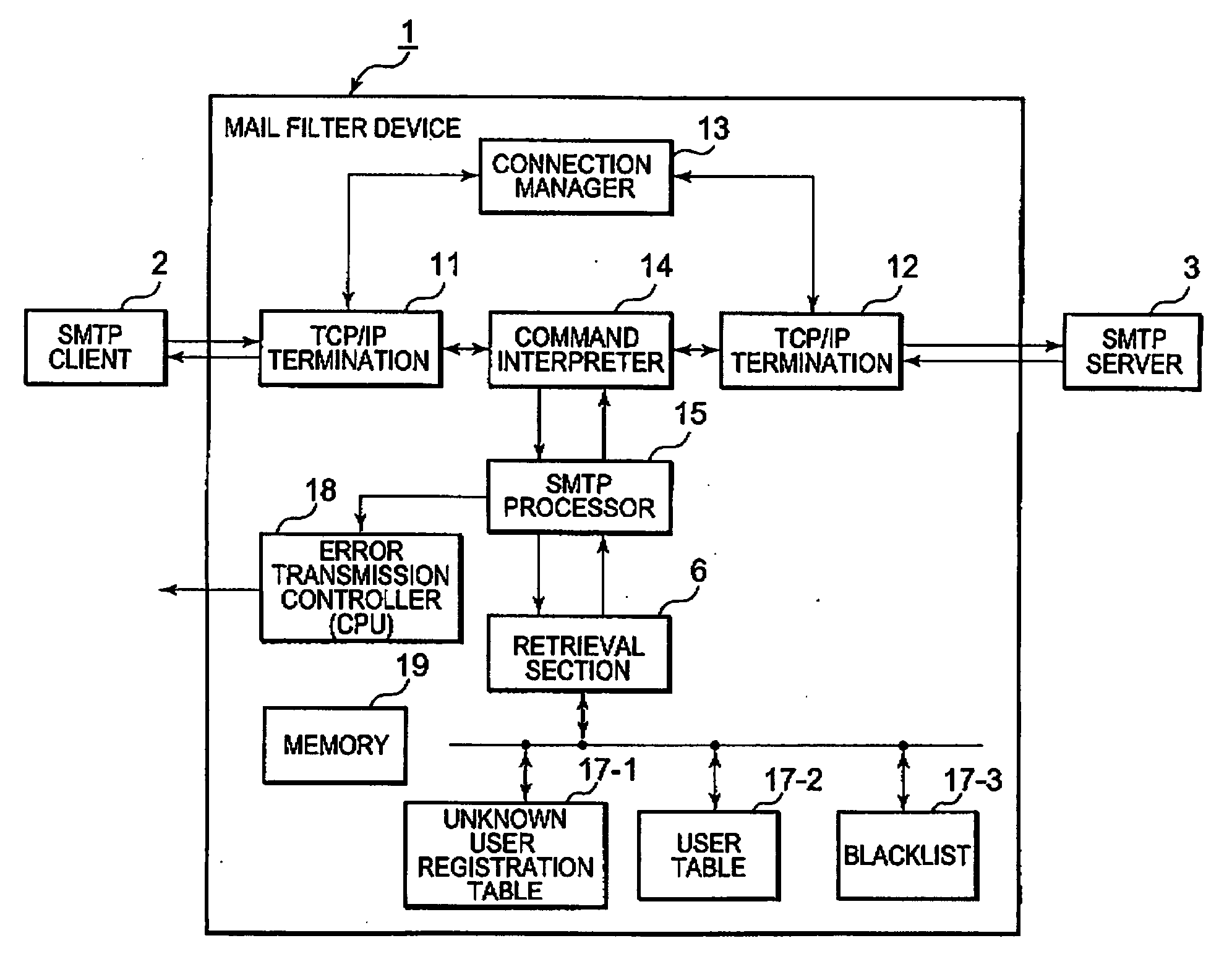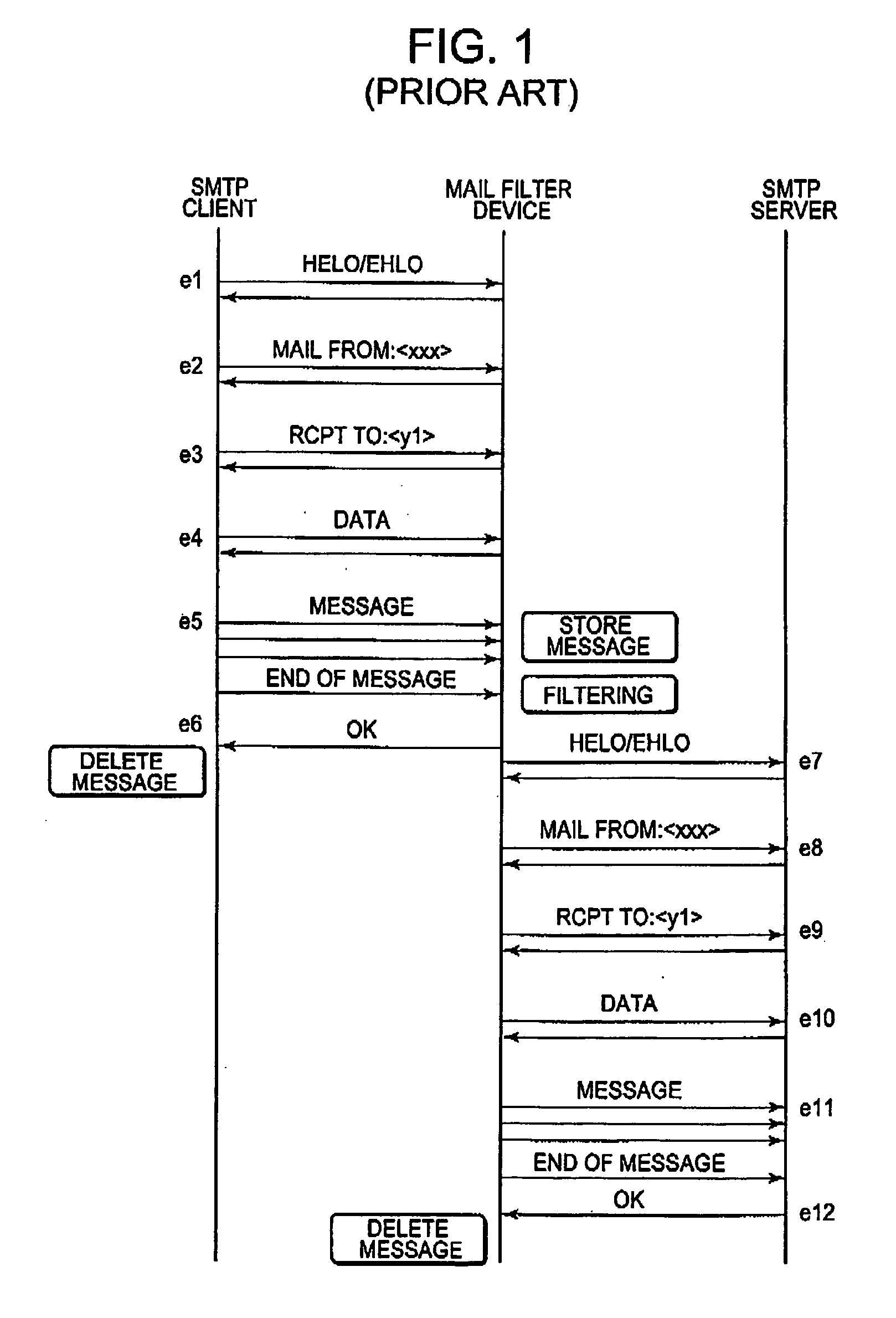Efficient mail filtering techniques
- Summary
- Abstract
- Description
- Claims
- Application Information
AI Technical Summary
Benefits of technology
Problems solved by technology
Method used
Image
Examples
example i
[0095] A first example shows the case where only an electronic mail with its check result being “disable” that is included in the blacklist 17-3 is permitted to pass through.
[0096] As shown in FIG. 11, the SMTP client 2 first issues a command such as HELO (HELLO) or EHLO (Extended HELLO) to the SMTP server 3. The mail filter device 1 receives this HELO / EHLO command and transfers it as it is to the SMTP server 3. When receiving a response to the HELO / EHLO command from the SMTP server 3, the mail filter device 1 transfers the response to the SMTP client 2 (step a1). Here, a HELO command is an opening command when a session is initiated. An EHLO command is an opening command for notifying a request asking the extended function. According to these commands, a session with a client is initiated at a server.
[0097] Subsequently, the SMTP client 2 issues a MAIL command for source address notification. The mail filter device 1 also transfers this MAIL command to the SMTP server 3 and trans...
example ii
[0108] A second example shows the case where the content check determines that a match is found in the blacklist 17-3 and the electronic mail is not delivered.
[0109] As shown in FIG. 12, HELO / EHLO command transfer (step b1) and MAIL command transfer (step b2) are similar to those in the first example as shown in FIG. 11.
[0110] In the RCPT command at the step b3, it is assumed that the destination address is designated as “y1” and the filter processing of “y1” is “enable”. Similarly, in the RCPT command at the step b4, it is assumed that the destination address is designated as “y2” and the filter processing of “y2” is “enable”.
[0111] Subsequently, the mail filter device 1 performs the content check on the message of an electronic mail received from the SMTP client 2 by exchanging DATA command and OK response (steps b5 and b6). If it is determined that a match is found in the blacklist 17-3, then “y1” and “y2” are deleted from a list of RCPT candidates, resulting in the number of ...
example iii
[0113] A third example shows the case where the content check determines that no match is found in the blacklist 17-3 and the electronic mail is delivered to all destination addresses.
[0114] In FIG. 13, steps c1-c7 are similar to the steps a1-a7 of FIG. 11. Here, it is assumed that destination “y3” is sent to the SMTP server 3 regardless of filter check result, the filter processing of “y1” and “y2” is “enable”, and destination “y4” is unknown and therefore a NG response is sent back.
[0115] Subsequently, the mail filter device 1 receives the message of the electronic mail from the SMTP client 2 and performs the content check (step c8). Assuming that no match is found in the black list 17-3 by the content check, mail transfer is also performed to the stored destinations “y1” and “y2”. Accordingly, the mail filter device 1 issues a RCPT command for “y1” and “y2” to the SMTP server 3. Mores specifically, at step c9, RCPT command is used to notify the SMTP server 3 of “y1” and, at ste...
PUM
 Login to View More
Login to View More Abstract
Description
Claims
Application Information
 Login to View More
Login to View More - R&D
- Intellectual Property
- Life Sciences
- Materials
- Tech Scout
- Unparalleled Data Quality
- Higher Quality Content
- 60% Fewer Hallucinations
Browse by: Latest US Patents, China's latest patents, Technical Efficacy Thesaurus, Application Domain, Technology Topic, Popular Technical Reports.
© 2025 PatSnap. All rights reserved.Legal|Privacy policy|Modern Slavery Act Transparency Statement|Sitemap|About US| Contact US: help@patsnap.com



